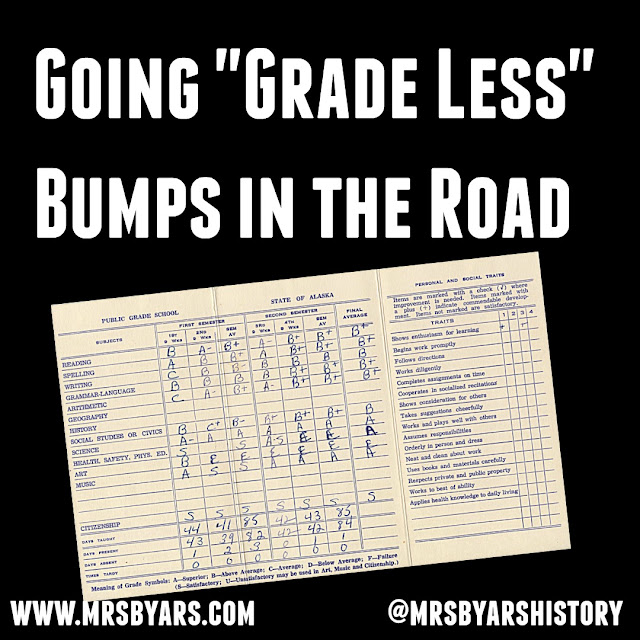Going "Grade Less": Bumps in the Road
This summer I am experimenting with reflective grading practices in my World History summer school class. It felt necessary to find a new approach to grading after months of reading and research and countless moments in my classroom where traditional grading systems just weren't cutting it. I was fed up with "how many points is this worth?" or "how many points do I need on this to just pass the class?" Many students weren't trying to learn, they often weren't trying to improve or achieve an academic goal, they were playing a game of points.
My first week of reflective grading still feels like a monumental success, students understand the process, students are listening to feedback and trying again on their work, and most students when asked how the process was going for them responded positively.
But a few students raised some excellent concerns in the first week that I'd like to share.
1) The 4 point rubric and the traditional online grade book my district uses to record grades don't work well together.
When I put in the first two objectives that students reflected on into our district required digital grade books, things became terrifying for some students. Students who had earned 3's were confused and in a panic: they thought they had done well and only needed to improve a little bit but the grade book was showing they were only earning a 75% or a C in the class.When planning, I had done the math a few times with a full set of grades in the grade book to see how a handful of low scores would impact a grade, I even had an example grade book up for students to see on the first day. But when real grades entered the grade book for the first time there were only a few scores in and it sent a shock through some students who are used to that 100 point scale.
But the digital grade book our district requires us to update every two weeks (every 3 days in summer school) only knows the 100 point scale and students who have traditionally had A's and B's only know a C as something negative. They don't see it as a starting point from which to improve. That was the message I had to work the hardest at selling the students, that number is temporary if you are willing to try again.
Students who brought up this point presented me with two challenges; developing that growth mindset culture in my classrooms and considering moving to a 5 point scale in the future in order to better fit the digital grade books calculations. If my goal is to give students a clear view of where they are at in my class, I need to ensure the few grades they do receive truly reflect where they are at.
2) "If you gave me a test I would pass it. I only pass this if YOU think I've explained myself well."
This comment made me extremely grateful for the time that the Station Rotation model gave me to speak with this student (actually it gave me time to talk to each student) one on one. I had the chance to talk to this student about what will happen in the real world, will they spend their lives taking multiple-choice tests to prove what they know? Or will they need to be able to explain themselves thoughtfully and with evidence? This is another paradigm shift that some students will need to face with reflective grading. I also still give quizzes but they don't go in the grade book, instead students immediately see what the answers are so they know what they still need to learn.When I went back to the standards and started writing clear learning objectives for students using "I can..." statements, I was a little shocked by how much of the historical content that we as history teachers so often test was missing from those standards. The standards rarely ask students to identify and almost always ask students to explain, summarize, or compare. Add that to the new CCSS Literacy Standards for History, and it's hard to defend building grades entirely around multiple choice tests in a history classroom.That being said, I know that in the traditional year having those tests as an option for students to use as evidence in their reflections will be a practice I use regularly.
Both of these concerns have led me to consider some changes for the school year when I attempt this grading system again. Overall, I still feel optimistic about this new approach to grading and it has me excited about planning, grading, and teaching like never before.
Have you tried a non-traditional grading method? Tell me about it in the comments!
-Mrs. Kathryn Byars




I caught my husband so many times through his chats and all about cheating on me and when i told him he always claims that he has changed and all..right now he hides his phone from me and i still guess he is cheating cause i could not break into his phone any more so i was referred to a group of hacker who i ran to for help and this hacker was able to break into his phone and provide me with the access to my husband phone without my spouse knowing about the hack..right in my phone i have all my husband phone daily activities in my phone i got to read all his chats, text, calls, whatsApp, Facebook, and many more this hacker is really great thank you. Did you find this review helpful? contact them and let them know i referred you
ReplyDeletewilliamscyberghost@gmail. com you can also reach them via WhatsApp, call, Signal or text +1 602 456 1862 @williamscyber.02.